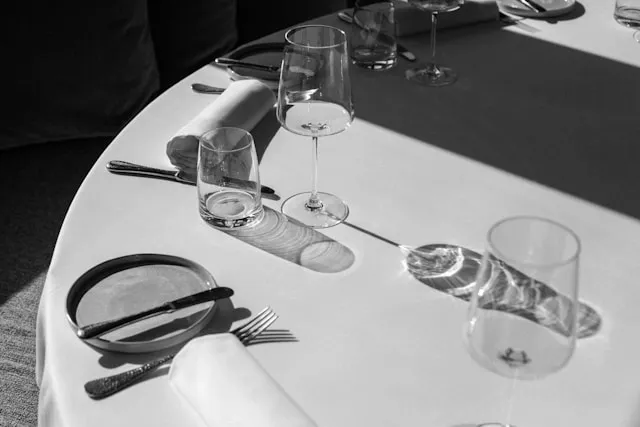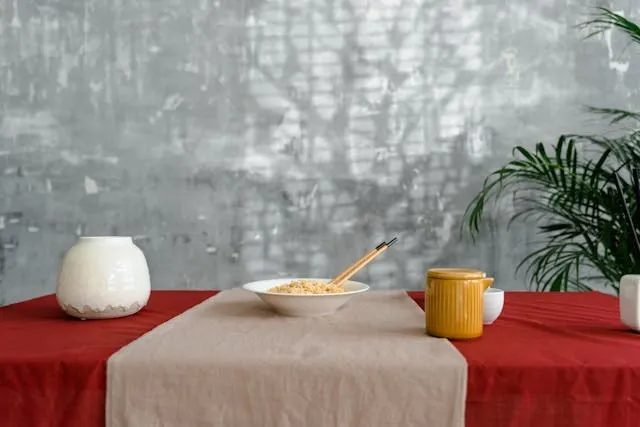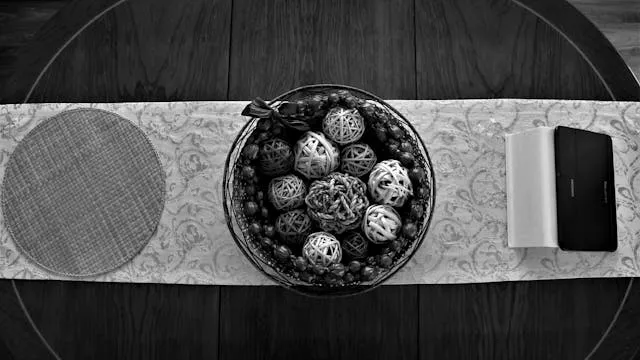How To Use A Table Runner? (Style Tips, Functions, And Table Décor Tips)
A table runner is a versatile and transformative decor piece to add to your table setting. Whether you’re hosting a formal dinner, a casual brunch, or simply updating your day-to-day style, knowing how to use a table runner properly can enhance the entire experience.
In this guide, we explore everything you need to know about table runner placement, combinations with placemats, and creative usage on different types of tables. Read on if you are ready to enhance your table decor.

Key Takeaways
- There are different ways to use table runners in formal and casual settings, with varying ideas about placement, length, and alignment.
- You can place table runners on top of tablecloths and combine them with placemats and/or coasters, with different etiquette rules for different occasions.
- Table runner usage can even extend beyond dining tables, but it is important to understand how to place and arrange them for symmetry and visual appeal.
- We supply custom table runners and other table covers that you can personalize with your own designs to adorn any table you want.
Table of contents
-
How To Use A Table Runner?
-
How Do You Place A Table Runner Correctly On Any Table?
-
Can A Table Runner Be Too Long Or Too Short?
-
Do Table Runners Go Horizontal Or Vertical?
-
How Do You Set A Table With A Runner?
-
Can You Use Placemats With A Table Runner?
-
What Are The Rules And Etiquette For Table Runner Usage?
-
Can You Use A Table Runner On Any Type Of Table?
-
Are Table Runners Considered Trendy In Modern Homes?
How To Use A Table Runner?
A table runner is a long strip of fabric that is traditionally placed down the center of a table to add style, structure, or protection. Historically, they are a feature of formal dining to guard against spills, but table runners have become a staple in both casual and elegant table settings with runner approaches.
To learn how to use table runners, you must first understand their role. They can be used:
- In tandem with tablecloths
- On their own
When exploring how to set a table with a table runner, always consider your event type, its theme, and the desired surface finish. Whether you are preparing a rustic brunch or a formal celebration, the proper way to place table runners enhances appearance and functionality.
Explore options to buy custom print table runners with us to get the perfect aesthetic.

How Do You Place A Table Runner Correctly On Any Table?
As you explore how to place a table runner, you will find that it starts with the table’s shape and size. Traditionally, table runners are centered lengthwise, hanging evenly on both ends - this classic table runner placement is best for formal events.
Modern styles have altered how to set a table runner. It could go across the width of the table for a fresh, casual look, for example. Whether you are setting for daily use or entertaining, make sure the runner spans the length without overwhelming the surface.
If you use two table runners, you could go with crisscross patterns or parallel placements for visual interest. Spacing is key, as proper alignment maintains balance.
Should A Table Runner Hang Over The Table?
The standard recommendation for table runner placement is to allow it to hang over the edges of the table by 6 to 12 inches. This will frame the runner nicely with a touch of visual elegance.
However, whether a table runner should hang over the edge depends on context. For sit-down dinners or formal gatherings, the overhang adds a refined touch. However, for buffet setups or casual family meals, many prefer a no-hang look to avoid interference.
Either method is valid, depending on your style and functional needs. Still, the most popular approach when dressing a table with a runner is to allow a 6-inch overhang.
Looking for the right balance of elegance and personalization in a table runner?
Work with us to create custom linen table runners made from polyester, matching the aesthetic of the iconic fabric. We offer maximum luxury, durability, and customization.
Can A Table Runner Be Too Long Or Too Short?
Table runners can definitely be too long or too short, which will disrupt the flow of your decor. When exploring how to set a table with a table runner, always measure the table first. A runner should extend to the ends of the table, or overhang the edges by 6-12 inches.
- Too long: Too much overhang could interfere with seating or create tripping hazards.
- Too short: This can make the setup look awkward or unfinished.
When you determine how to use a table runner properly, remember that dimensions vary by table shape. Round tables usually benefit from a shorter, centered runner, while rectangular ones can handle extended lengths.
Table runner placement is intended to enhance - not overpower - your table setting with runner.
Does A Table Runner Go Over A Tablecloth Or Alone?
Understanding how to use table runners includes knowing whether they belong over a tablecloth or on their own - both options are correct. A table runner on top of a tablecloth is an approach to tablescaping, creating a layered, sophisticated appearance that works well for things like:
- Weddings
- Holiday dinners
- Formal settings
Meanwhile, a table runner by itself provides a cleaner, more contemporary look that fits well with minimalist and rustic interiors.
Choosing how to set a table with a table runner depends on texture and tone. You can create depth by pairing vibrant prints over neutral cloths or mixing linen runners with lace. Ultimately, layering is a stylistic choice tailored to your needs.

Do Table Runners Go Horizontal Or Vertical?
The traditional table runner placement is vertical. It should be centered down the length of the table with matching overhangs. However, creative decorators now embrace placing a table runner across the width of the table.
This twist on the traditional style is particularly popular on square or rectangle tables, where horizontal runners mimic placemats for pairs of diners. Thus, the answer to which way a table runner goes is that it is flexible. Some even take the bold choice of placing them diagonally for restive or artistic tablescapes.
The choice of direction should reflect the occasion, aesthetic, and seating arrangement. When you work with us, you can order custom bulk table runners tailored to your aesthetic and place them however you want on tables.
Create personalized table runners for your wedding with diverse options
We offer custom personalized wedding table runners with monograms, dates, and other printed designs to help make your wedding reception tables truly stand out.
Explore optionsHow Do You Set A Table With A Runner?
Learning how to set a table with a runner involves both practicality and aesthetic choices. The first step is to choose a runner that fits your table’s length, and allow a 6-12 inch overhang at both ends if this is what you want.
From here:
- Positioning: Center it along the table’s length or across the width for a modern twist.
- Add decorations: Once the runner is laid out, position centerpieces, dishes, and cutlery in alignment.
- Symmetry: Whether using table runners with pictures for reference or simply experimenting, this is important.
Table settings using runners benefit from cohesive arrangements. Ensure plates aren’t crowding the runner’s edges. Knowing how to decorate with table runners means enhancing your tablescape, not overpowering it.
Can You Use Placemats With A Table Runner?
You can, and often should, use placemats with table runners. Doing so adds dimension and definition to each place setting. The same goes for things like coasters and cloth napkins. However, learning how to use table runners with placemats requires spacial awareness.
The key is harmony, not clutter. Choose placemats that complement your runner in terms of color, texture, and material. If you’re wondering how to set a table with a table runner and placemats, keep the runner centered and place each mat in front of the chairs without overlapping.
When you get this right, the combination elevates your table setting in terms of both form and function. Avoid heavy layering that might disrupt flow - it’s all about coordination, not competition.
How To Set A Table With A Runner And Placemats
When setting a table with a runner and placemats together, aim for maximum symmetry and clarity. Begin by laying the table runner down the center of the table, whether you choose to do this lengthwise or widthwise.
Once this is done, do the following:
- Placemat placement: Position placemats directly in front of each seat, ensuring they don’t sit on top of the runner if it is narrow.
- Overlap if necessary: With wider runners, a slight overlap is acceptable if the materials contrast well.
Proper table runner placement ensures your table doesn’t look congested. With this setup, you have the perfect look for semi-formal events where elegance meets convenience. If you are unsure of anything, test combinations beforehand and use table runner pictures for guidance.
Need large quantities of customized white table runners?
When you work with us, you can order custom white table runners in bulk with generous wholesale discounts to adorn tables at weddings, banquets, restaurants, and more.
What Are The Rules And Etiquette For Table Runner Usage?
There are a few timeless guidelines when considering table runner placement and etiquette. From cleanliness to positioning, let’s look at the most important ones:
- Neatness: Your runner should be clean, wrinkle-free, and aligned with the center of the table.
- Symmetry: This is the fundamental rule of thumb when considering how to put a table runner on table surfaces properly.
- Formality: Create a formal look by avoiding loud patterns or clashing colors.
- Balance: Don’t let other elements like oversized centerpieces overwhelm the runner.
- Themes: Your table runner should complement the overall theme.
Always ensure the runner’s materials and tone are aligned with the surroundings. For example velvet captures a sense of winter elegance, while linen evokes breezy summer charm.
Can You Use A Table Runner On Any Type Of Table?
A table runner can work on virtually any type of table. The key is to respect its dimensions and shape, as there are slightly different considerations for different table shapes.
- Round tables: The most common approach is to center the runner without overhang, particularly in compact spaces.
- Rectangular/oval tables: Traditional centered placement is best, with slight overhangs.
- Square tables: Table runner width-wise arrangements are a good option, particularly if you want to distinguish place settings.
Table runner set up is as suitable for rustic farmhouse tables as it is for modern glass dining tables. When you work with us, you can create custom table runners optimized for any table shape and setting with options to personalize the size, colors, and bespoke design.
Should You Use A Table Runner On A Glass Table?
Glass tables can work well with table runners, but you should be careful - research has found that glass table injuries are surprisingly common with heavy-handed usage. Wondering how to use table runners on glass? They have several main functions here:
- Add warmth
- Reduce visual starkness of the glass
- Prevent smudges or scratches from dishware
A table runner on top of a tablecloth isn’t always necessary with glass - the runner alone can suffice. We recommend choosing colors and designs that contrast with the reflective surface - neutral tones are best.
Knowing how to set a table with a runner on glass means avoiding slippery fabrics. Use non-slip pads underneath for extra security. The look can enhance form and function to make your glass table feel cozy, intentional, and stylish.
Can You Use A Table Runner On Coffee Tables Or Sideboards?
Table runners aren’t just for dining. You can use a table runner on coffee tables, sideboards, or entry tables for instant charm that adds definition to the surface. This is particularly effective in living rooms or foyers where you want to highlight decorative items.
If you are wondering how to use a table runner on smaller surfaces, the answer is to center the runner and let it hang slightly. Alternatively, use a no-overhang approach for clean minimalism. Layer it with things like:
- Candles
- Trays
- Seasonal decor
You then have a reliable base to add your custom coffee mugs when using them. The proper way to place table runners on furniture like this depends on your style, be it boho, rustic, modern, or anything else.

Need another table cover to help highlight your table runner?
Whether to contrast or complement your table runner, work with us to create custom printed tablecloths that add a touch of style and extra protection to your tabletop.
Get startedAre Table Runners Considered Trendy In Modern Homes?
You may be wondering if table runners are out of style. The answer is no - they are enjoying a resurgence in modern interior design with trends like minimalism, cottagecore, and rustic-industrial aesthetics. They are seen as practical yet artistic tools for layering.
Wondering which way a table runner goes for modern spaces? Often, it goes across the width or is laid diagonally. As people seek simplicity, table runner setup using natural fibers, neutral tones, or personalized patterns have become popular choices.
Whether you are styling for a formal dinner or casually layering a table runner on top of a tablecloth for visual interest, they remain a go-to accessory. They are also affordable style updates, particularly when you buy custom table runners from our online store.
Frequently Asked Questions About How To Use A Table Runner
Can You Use A Table Runner Without A Tablecloth?
Yes, using a table runner without a tablecloth is a popular choice in minimalist settings. It allows your table’s material to shine through while still providing a visual anchor for centerpieces.
Should A Table Runner Hang Over The Table Or Not?
This depends on the occasion. For formal dining, a 6-12 inch overhang at both ends is ideal. For casual settings, or on smaller surfaces, no overhang may be better.